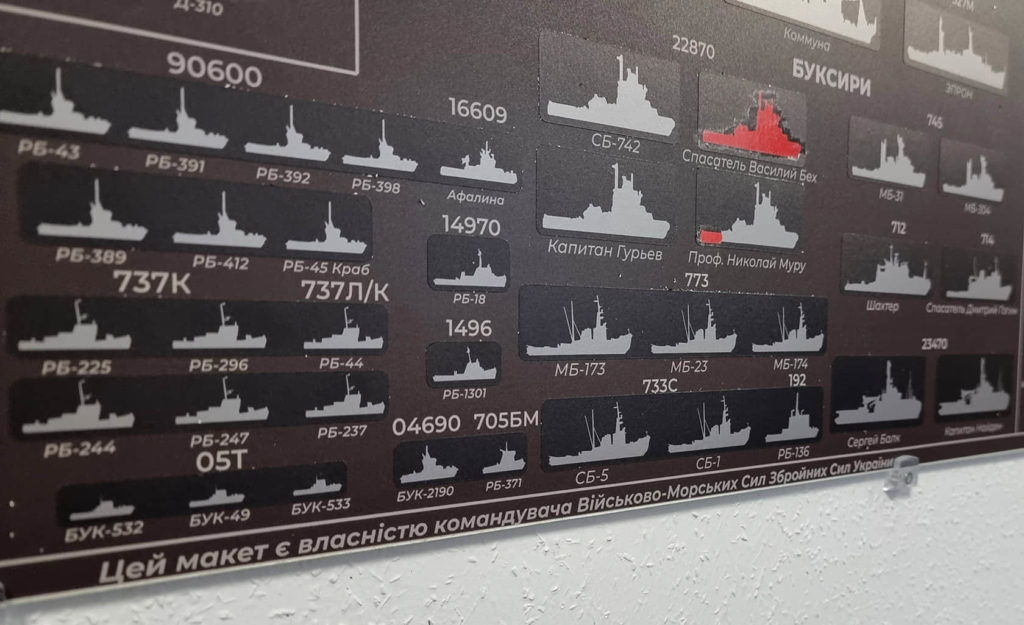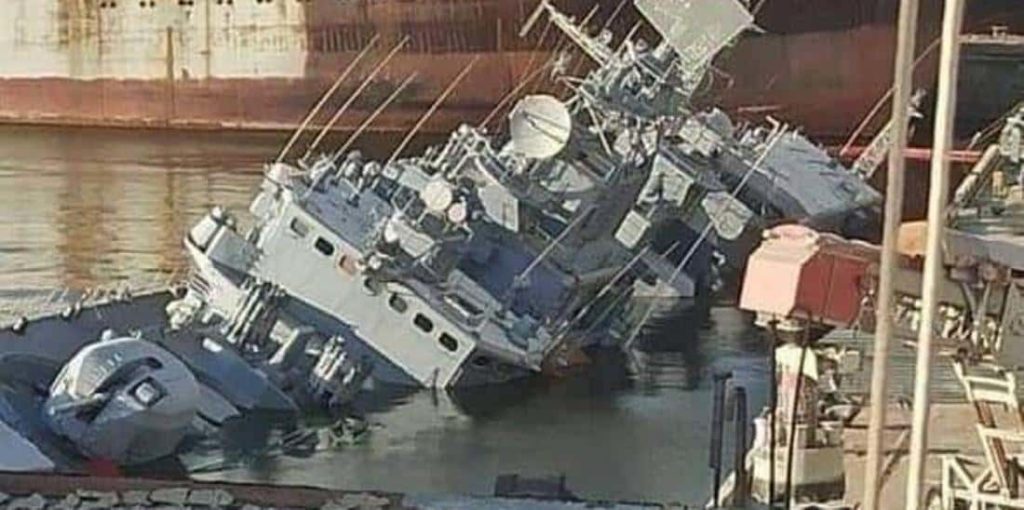Ukraine's military successes in the Black Sea, often overlooked in the West, surprise many. Despite last year's counteroffensive being seen as not very successful, Ukraine has actually made significant progress: having no navy to speak of, it created the world's first fleet of marine drones and paralyzed Russia's once-formidable Black Sea Fleet.
Vice Admiral Oleksii Neizhpapa, Commander of the Navy of the Armed Forces of Ukraine, played a key role in these achievements. Born in Sevastopol, now under Russian occupation, Neizhpapa remained loyal to his oath. Operating from Odesa, he meticulously tracks the Russian Black Sea Fleet's composition on a scratch map, marking successes after each naval operation.

Can Ukraine liberate Crimea with the help of naval drones? Did Türkiye really block British-gifted minesweepers from entering the Black Sea for Ukraine? Roman Romaniuk from Ukrainska Pravda spoke with Neizhpapa about this and much more. Euromaidan Press has selected the most interesting parts from this interview.
Ukraine sank its flagship Hetman Sahaidachny. Why?
We knew a great war was coming and were preparing. The Ukrainian Navy had created a certain grouping, which was dispersed, so no warships were damaged in the early days of the war. Naval aviation was also lifted from airfields and thus did not suffer significant losses.
The only major loss was the frigate Hetman Sahaidachny, which was under repair in Mykolaiv when Russia invaded. It had no power, all diesel generators were to be replaced, turbine repairs were underway, and all weapons were out of order. Meanwhile, the Russians were already on the outskirts.
"As a warship that could have taken part in repelling aggression, it could not fulfill its role. Therefore, the commander made a reasonable decision. As the "Regulations on Ship Service" say: a ship must not fall into enemy hands," Neizhpapa explained.

How Ukraine prevented Russian amphibious assault
The Russians aimed for an amphibious assault, a highly intricate naval operation dependent on air and sea supremacy. Typically executed as part of the main attack, it requires favorable land conditions.
The Russians advanced on Mykolaiv and went around it to enter the rear of Odesa Oblast. Had they not been stopped there by Ukraine’s 80th Air Assault Brigade, all the conditions for a Russian amphibious landing would have emerged. In addition, the Ukrainian Navy’s strikes on the Russian frigate Admiral Essen and the sinking of the cruiser Moskva forced the Russians to abandon their landing plans.
The strike on the Admiral Essen was the first success of Ukraine’s Neptune anti-ship missile. This happened when the frigate, accompanied by landing ships, approached the Ukrainian coast heading towards the resort village of Rybakivka in Mykolaiv Oblast. It was a feint so that the Ukrainians would not be able to redeploy any of their naval infantry units.
"The enemy wanted to keep us in constant tension, anticipating an imminent amphibious assault landing," says Neizhpapa.
It was then that the Ukrainians tested the Neptune missile, which exploded near the Admiral Essen, damaging it. Several Russian sailors were killed, and the frigate urgently returned to occupied Sevastopol for repairs. In the process, the warship inadvertently shot down a Russian plane providing air cover.
Why Russia captured Ukraine’s Zmiinyi Island on day one of the invasion
Ukraine’s Zmiinyi (Snake) Island in the Black Sea is now well protected - it is defended by coastal missile forces and medium-range air defense systems. However, in the early stages of the invasion, the Russians easily captured it since the Ukrainian garrison lacked full air or naval support. It could have repelled a potential attack by Russian special operations forces, but not full-scale aggression. There were attempts to evacuate the Zmiinyi Island garrison, but due to bad weather they did not have time.
By seizing the island, Russia gained a bridgehead to control shipping on the Danube, in Odesa and around it.
"Raiding actions were carried out from this island with enemy boats towards the Danube. They tried to mine the approaches to the estuary. There were even firefights between these boats and Ukrainian Navy boats directly in the Danube itself," Neizhpapa recalls.
Also, Russian ships under the leadership of the Moskva cruiser completely isolated the area from Crimea to the Danube, to prevent ally ships from accessing the combat zone.
Destruction of the cruiser Moskva
The cruiser Moskva (Moscow) was the pride and flagship of the Russian Black Sea Fleet. Without a cruiser, a first rank ship, it is not a fleet but a flotilla. The cruiser participated in all post-Soviet conflicts, including in Georgia and Syria. And before the invasion of Ukraine, the ship underwent a complete overhaul and upgrade.
The loss of the Moskva is a major blow to Russia's image. Although from a military point of view, this cruiser should not have been in the Black Sea. It was designed during the Cold War to destroy American aircraft carriers in the ocean. There are no aircraft carriers in the Black Sea, their entry is prohibited by the Montreux Convention.
However, the Moskva could comfortably accommodate a command post. There were large cabins, an elevator through 7 decks, and a swimming pool. In addition, the ship had good air defense systems, including the naval version of the S-300 complex.
"The Moskva performed several functions: command post, air defense ship and a symbol that - "Moskow came with war". Everything begins with Moskva, and I guess everything will end with it," said Neizhpapa.
The cruiser was destroyed by the forces and means of the Ukrainian Navy from start to finish: from detection to destruction. The Ukrainians realized they had hit it when all the ships that were next to the cruiser began heading towards it, while it itself stopped moving. Almost a day later, the cruiser sank.

After that, Russian ships stopped approaching the Ukrainian coast closer than 100 nautical miles (about 180 kilometers). The northwestern part of the Black Sea, almost 25,000 square kilometers, has become a gray zone that is not fully controlled by anyone.
Drones alone won't overcome Russia's Black Sea fleet
Any war drives military technology. Ukrainians employ new tech, Russians develop countermeasures. So some tactics proven in 2022 and 2023 will already fail by 2024.
The war of the future will see drone battled drone, but maritime operations have unique complexity. Drones have limitations around size, weapons loads, and ability to withstand weather – things that distinguish them from ships.
The Russians understand this too, and will deploy drones at sea much as they do on land. They too are learning, boast a powerful defense industry, and spare no expense.
"Simply switching the fleet over to drones and defeating the enemy will not work. You can only consider a territory yours when your soldier's or marine's boot is standing on it. The same goes for the seas. Only when your ship commands those territorial waters, and no one can do anything about it, are they truly yours," explains Neizhapapa.
Sevastopol vs Novorossiysk naval bases
Sevastopol is the logistics hub of the Russian Black Sea Fleet, built up over centuries. It houses stockpiles of munitions, fuel stores hidden in the mountains that are hard to strike, and Kalibr cruise missiles. It is also home to medical facilities, a large hospital, training institutes, repair yards, and airfields. In short, Sevastopol is the main base that fully sustains the fleet.
Meanwhile, the port at Novorossiysk lacks the capacity to support the Black Sea Fleet. It has no airfields, large repair facilities, or weapons storage akin to those in Crimea.
"Sevastopol is an enclosed bay, geographically well-suited for basing ships, shielded from all winds except the westerlies. Quite symbolic, actually. Novorossiysk, however, experiences nasty winds called boras - fierce gusts barrelling down from the Caucasus mountains, making the port a perilous anchorage," explains Neizhapapa.
Russia has reduced reliance on Sevastopol and Feodosia in occupied Crimea due to the Ukrainian threat - not just drones, but Storm Shadow missiles used to strike Black Sea Fleet headquarters in Sevastopol. For the first time, they sank a submarine right at the pier, the powerful new Rostov-on-Don. The missiles also hit the modern missile corvette Askold before the Russians could commission it.
Russia is building a new naval base in occupied Abkhazia
(a region in the Caucasus nominally part of Georgia but controlled by Russia). It will likely serve to disperse ships, rather than keep the whole fleet at one base.
Did Türkiye really deny passage to the minesweepers the UK handed over to Ukraine?
In early 2023, Britain transferred two minesweepers - Cherkasy and Chernihiv - to Ukraine. Though still based in the UK undergoing NATO-standard training, they are now part of Ukraine's navy.
However, Ukraine did not request passage through the Bosporus as the Montreux Convention prohibits this. Otherwise, Russia could do the same to increase its missile ships and landing vessels. Yet for some reason, media reported that Türkiye refused passage to Ukraine's minesweepers.
"I think this is a misunderstanding. I can only guess, but minesweepers heading from Britain to Romania look identical to ours. Perhaps that spawned the press coverage," surmises Neizhapapa.
Talks are also underway on involving NATO ships to secure civilian shipping to Ukrainian ports. But whether this will happen remains unknown - it's a political issue.
Türkiye, Bulgaria, and Romania have launched a joint mission to demine the Black Sea. Ukraine proposes a phased approach:
- Clearing mines during the ongoing war, within Montreux Convention limits;
- Removing drifting mines with Ukraine joining in coordination;
- A full-scale mine countermeasures operation after the war ends. The Ukrainian navy has established a headquarters, is training personnel, and minesweepers are already available that will deploy to the Black Sea post-war.
After the war, priority is clearing lanes needed for civilian shipping - the sea has highways too. This could take 5-7 months depending on assets.
Ukraine will have two minesweepers, getting another from the Netherlands in 2024 and one in 2025 - a full minesweeping division. NATO assistance would accelerate the process. But clearing all combat zones in the Black and Azov Seas could take years.
Read more:
- David topples Goliath: Ukraine's DIY naval drones outfox Russia's Black sea fleet
- Ukraine’s SeaBaby naval drones can now engage in sea battles, not only carry explosivess
- Ukraine spymaster: Even 30% of naval drones that reach targets problem for Russia
- Ukraine’s innovative naval tactics shifted balance of power despite lack of warships
- Zelenskyy: Ukraine to produce 1 million drones next year

